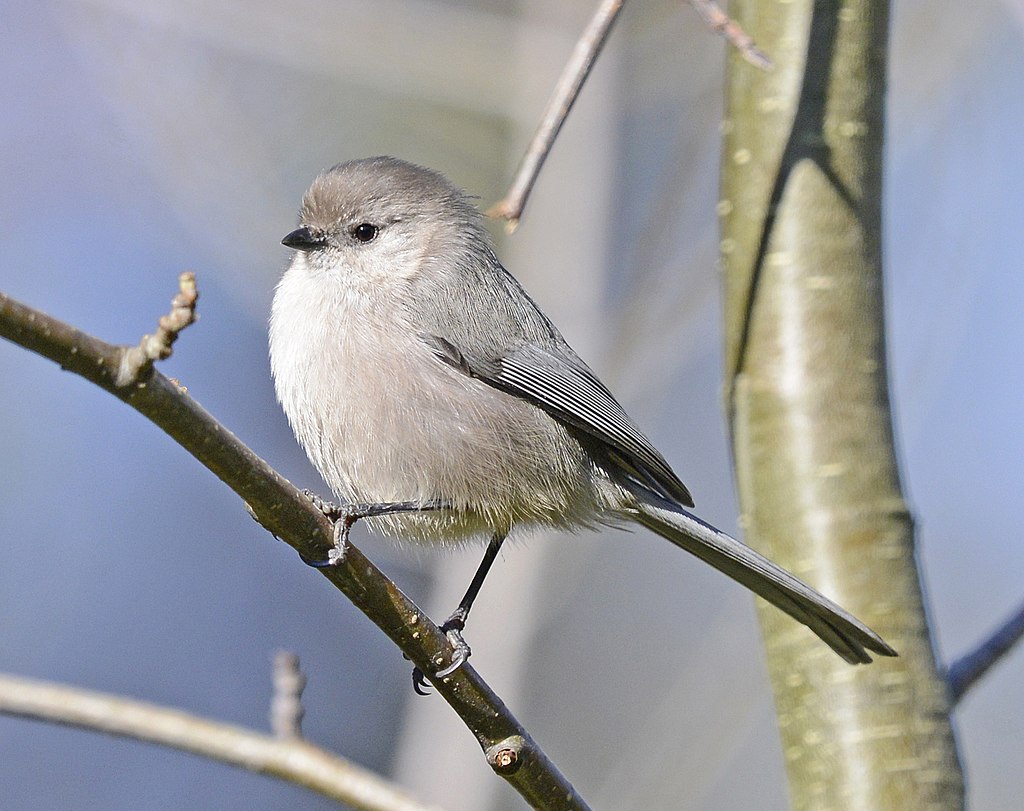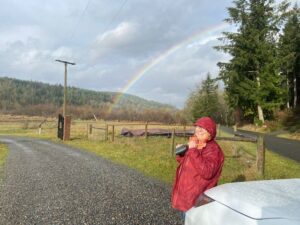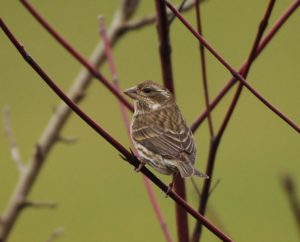By Sharon Moore
Bushtit – Psaltriparus minimus
Order: Passeriformes
Family: Aegithalidae

Have you ever wandered through an urban neighborhood looking up into the tree canopy and down into the shrub understory searching for bird nests? On just such a mission one spring morning in Olympia’s Capitol Neighborhood, I was disappointed, after nearly an hour, at not finding any active nests. About to walk on, I glanced around the yards in my view and glimpsed some unusual, long shapes hanging from a heavily leafed deciduous tree. What could those be? I wondered. Binoculars in hand, I focused on a number of tiny birds, which I couldn’t identify, moving quickly in and out from what I now saw were hanging nests. That marked my delighted discovery of a busy Bushtit flock readying their “homes” to welcome new families of nestlings.
My reading later that day revealed that just one species of this small avian family, Aegithalidae, occurs in the New World. Even more interesting is that Bushtits have arrived in the Pacific Northwest only in the last half-century or so. These diminutive birds barely measure 2.8” to 3.1” long and weigh a mere 0.1 to 0.2 oz. With long tails and stubby, short bills, they are large-headed and appear plump for their size. Blending colors from brown to gray, they have brown crowns, gray wings and light gray breasts.
Bushtits live from sea level to 10,000 ft. Though they don’t migrate south for the winter, they may travel to lower altitudes joining other Bushtit flocks, huddling together in dense vegetative cover for protection from cold weather. Highly sociable and energetic, these tiny, animated birds fly in busy family flocks of 10 to 40 birds. Moving through open evergreen woodlands, along streamsides and around urban and suburban landscapes their search for food is constant. Spiders as well as aphids, ants, wasps, beetles and caterpillars which the Bushtits forage from the undersides of leaves make up their primarily diet. Occasionally, they even feed on berries and seeds. Though Bushtits rarely frequent yard feeders, you might attract them to your property by densely planting more native shrubs and small trees. In winter there’s a slight chance they may also appreciate hulled sunflower seeds, suet, mealworms and peanut hearts you offer at your feeders.
These lively birds display many interesting characteristics. Often they mix with other small songbirds such as kinglets, chickadees and warblers when foraging. Tiny acrobats, they hang upside down as they move along tree branches in search of tasty protein, calling continuously with high-pitched chips and twitters to stay close to the flock. Though they have no real song, they will mob predators using loud, intense calls. Their full alarm call is shrill. When foraging, they fly single-file, generally short distances, behind one specific leader. Due to their small wings, they are not strong flyers.
The nest-building responsibilities of Bushtits are complex. To begin, the monogamous male and female explore possible nest sites by hanging spider webs on various branches of tree-trunks from heights of 3 to 100 ft. Once they choose a site, they may spend from one to two months building their architecturally intricate hanging nest. During construction they create a stretchy sac with spider webs, grasses and moss. As they continue the building process they might stretch the nest downward by sitting in it for a while. Ultimately the nest may be 12 inches long with a hole in the side near the top that leads down into the nest. The interior finishing touches include soft plant fiber, fur and feathers. The pair camouflages the outside with material from the tree in which the nest now hangs. We can thank the Bushtits for being recyclers. Next spring they will move their old nest material to use at their new site.
Bushtits’ spring breeding activities are intense. Clutches are normally 4 to 10 eggs, the incubation period is 12 to 13 days and the nesting time is 18 to 19 days. Both parents incubate and share the brooding and feeding of the young. They often have helpers with the feeding responsibilities from usually unmated males or breeders whose own nests have failed. While the young occupy the nest, the breeding pair plus helpers all sleep in the nest as well. Once the first set of nestlings is raised, the bonded pair usually remains at the nest to raise a second brood in the same season. An interesting phenomenon with these birds is that some nests contain huge clutches of eggs thought to result from communal nesting in which several females place eggs in one nest. The reasons for this complex social system are not well understood.
Bushtits have been here long enough now to be considered fairly common birds in the Pacific Northwest. They adjust well to various types of habitat; hence, their populations are quite stable. Given its general stability, the species’ wide, variable habitat choices suggest it is often adaptable to various conditions in many ecosystems. In the future, this adaptability may help the Bushtit to survive at least in the early decades of projected climate change. During summer in the Pacific Northwest, if temperatures rise by 1.5 degrees Celsius (2.7 degrees Fahrenheit), the Bushtit is predicted to lose 30% of its range. However, if the species is able to relocate, it may regain up to 19% of its lost range. For winter, the numbers point to a similar possibility. If the Bushtit can move to higher, cooler ground such as the Olympic Peninsula, it may regain 22% of the range it will have lost at lower, warmer elevations. Should temperatures continue to rise, nearly all bird species will find less range in which they can survive, and the likelihood of extinctions will be high. And certainly these rising temperatures will put all other wildlife and humans at risk as well.







